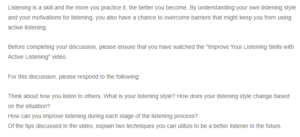Active Listening – Understanding Your Style and Overcoming Barriers
When it comes to listening, I try and practice three things. First, I try to have the utmost concern for the other person’s feelings. Second, I try to be responsive to their emotional states, and thirdly, I am interested in hearing their personal information and trying to find whether we have areas of common interest. I discovered that this listening style makes me more empathetic, have conversational sensitivity, and be less verbally aggressive and apprehensive. I mostly use This people-oriented listening approach when talking to people in my personal circle. However, this changes in a more formal context, like when talking to a teacher or in a class discussion. In such contexts, I normally use content-oriented listening.
To help improve my listening skills during each stage of the listening process, I need to learn more about nonverbal communication. Some nonverbal cues that I could pay attention to are the voice tones of the speaker so that I can understand their feelings. Some aspects of voice tone include pitch, speech rate, loudness, pauses and timbre, which can convey the emotions one feels at the moment, also known as emotional prosody (Wildgruber et al., 2006; Hamilton, 2016).
After watching the video, I learned two techniques I can use to be a better listener in the future. These techniques include putting my thoughts on hold and not trying to think about how I will respond. I tend to do this sometimes, and it distracts me from paying attention to the speaker. Secondly, I learned that I should recognize how my personal filters and judgements affect my ability to interpret a message, which can lead to miscommunication (MindToolVideos, 2015). As such, I will try to ask for more details about the information I think is vague, misunderstood, or complicated.
References
Hamilton, C. M. (2016). Communicating for success. Routledge.
MindToolVideos, (2015). Improve Your Listening Skills with Active Listening. YouTube. https://www.youtube.com/watch?v=t2z9mdX1j4A
Wildgruber, D., Ackermann, H., Kreifelts, B., & Ethofer, T. (2006). Cerebral processing of linguistic and emotional prosody: fMRI studies. Progress in brain research, 156, 249-268.
ORDER A PLAGIARISM-FREE PAPER HERE
We’ll write everything from scratch
Question
Listening is a skill and the more you practice it, the better you become. By understanding your own listening style and your motivations for listening, you also have a chance to overcome barriers that might keep you from using active listening.

Active Listening
Before completing your discussion, please ensure that you have watched the “Improve Your Listening Skills with Active Listening” video.
For this discussion, please respond to the following:
Think about how you listen to others. What is your listening style? How does your listening style change based on the situation?
How can you improve listening during each stage of the listening process?
Of the tips discussed in the video, explain two techniques you can utilize to be a better listener in the future.


